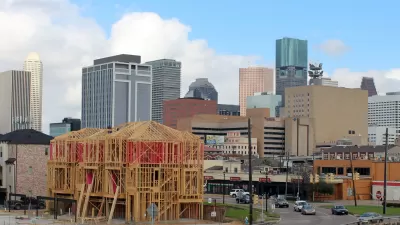Author Alan Ehrenhalt says that conditions are ripe for the permanent return of downtown residential neighborhoods, and that a "demographic inversion" has already begun in Manhattan, Chicago and Washington, DC, among other cities.
In its August issue, The New Republic takes a look at Chicago as a case study for the influx of the middle-class back into downtown areas. "To describe what has happened virtually overnight in Logan Square [a neighborhood north of the Loop] as gentrification is to miss the point. Chicago, like much of America, is rearranging itself, and the result is an entire metropolitan area that looks considerably different from what it looked like when this decade started."
"There are responsible critics who argue that, in absolute numbers, the return to the urban center remains a minor demographic event. They have a point But, even if the critics are mostly right there is no doubt that a demographic inversion, in which the rich are moving inside and the poor are moving outside, is taking place. The crucial issue is not the number of people living downtown, although that matters. The crucial issue is who they are, and the ways in which urban life is changing as a result."
Ehrenhalt suggests that the move to downtown residential areas is part backlash on the part of suburban-bred twenty-somethings; part a response to a decrease in urban crime; and part a response of wealthy empty-nesters who want to take advantage of urban activity. He also points to demographic changes such as later marriage and the rise of cohabitation as trends that make a demographic inversion "not only possible but likely."
Thanks to Franny Ritchie
FULL STORY: Trading Places: the demographic inversion of the American city

Study: Maui’s Plan to Convert Vacation Rentals to Long-Term Housing Could Cause Nearly $1 Billion Economic Loss
The plan would reduce visitor accommodation by 25,% resulting in 1,900 jobs lost.

North Texas Transit Leaders Tout Benefits of TOD for Growing Region
At a summit focused on transit-oriented development, policymakers discussed how North Texas’ expanded light rail system can serve as a tool for economic growth.

Why Should We Subsidize Public Transportation?
Many public transit agencies face financial stress due to rising costs, declining fare revenue, and declining subsidies. Transit advocates must provide a strong business case for increasing public transit funding.

How to Make US Trains Faster
Changes to boarding platforms and a switch to electric trains could improve U.S. passenger rail service without the added cost of high-speed rail.

Columbia’s Revitalized ‘Loop’ Is a Hub for Local Entrepreneurs
A focus on small businesses is helping a commercial corridor in Columbia, Missouri thrive.

Invasive Insect Threatens Minnesota’s Ash Forests
The Emerald Ash Borer is a rapidly spreading invasive pest threatening Minnesota’s ash trees, and homeowners are encouraged to plant diverse replacement species, avoid moving ash firewood, and monitor for signs of infestation.
Urban Design for Planners 1: Software Tools
This six-course series explores essential urban design concepts using open source software and equips planners with the tools they need to participate fully in the urban design process.
Planning for Universal Design
Learn the tools for implementing Universal Design in planning regulations.
Ascent Environmental
Borough of Carlisle
Institute for Housing and Urban Development Studies (IHS)
City of Grandview
Harvard GSD Executive Education
Toledo-Lucas County Plan Commissions
Salt Lake City
NYU Wagner Graduate School of Public Service





























